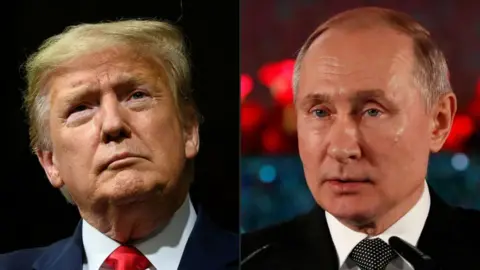In a significant diplomatic development, US President Donald Trump and Russian President Vladimir Putin are scheduled to meet in Alaska next week, specifically on August 15, to discuss the ongoing conflict in Ukraine. This announcement, revealed by Trump on social media, was subsequently confirmed by a Kremlin spokesperson. The choice of Alaska as the meeting location has been described as “quite logical” due to its geographic proximity to Russia, laying the foundation for a potentially fruitful dialogue between the two leaders.
During the announcement, the Kremlin indicated that Trump had received an invitation to hold a second summit in Russia. Notably, there was no immediate response from the Ukrainian government regarding this impending meeting. Trump’s announcement arrived shortly after he suggested that Ukraine might need to consider territorial concessions to bring an end to the war that commenced with Russia’s full-scale invasion in February 2022. Trump remarked on the complexities of the situation, stating that “a lot of Russians have died and a lot of Ukrainians have died,” underscoring the tragic toll the conflict has taken.
In a deeper exploration of his views, Trump hinted at the possibility of “swapping” territories, meaning both Ukraine and Russia could potentially exchange control over certain areas, which he believes could be beneficial for both nations. Despite his optimistic outlook, Trump did not provide explicit details regarding this proposal. Reports from CBS News suggest that the US administration is endeavoring to persuade European allies to accept an agreement that would entail Russia retaining hold over the entire Donbas region in eastern Ukraine, as well as Crimea, while Ukraine would shed the partially occupied Kherson and Zaporizhzhia regions.
This event follows some prior discussions between Putin and Trump’s envoy, Steve Witkoff, who allegedly discussed a similar arrangement during a recent meeting in Moscow. The dynamics are complicated by the persistent differences between Ukraine and its European allies on one side, and Russia’s demands on the other. Ukrainian President Volodymyr Zelensky has firmly rejected any proposals that include preconditions for ceding territory, highlighting the significant distances that remain between the conflicting parties on peace terms.
Additionally, planning for the upcoming meeting remains fluid, with reports indicating that Zelensky could potentially be involved in some capacity. Despite Moscow’s persistent military efforts, including occupying around 20% of Ukraine’s territory, substantial breakthroughs have not materialized, nor has there been effective progress toward peace since three direct talks held in Istanbul that failed to yield any conclusive agreements. Russian demands from Ukraine remain starkly opposed by Kyiv, with Moscow insisting on conditions such as Ukraine’s neutrality, the downsizing of its military forces, and the lifting of sanctions imposed on Russia by the West.
In the backdrop of these ongoing discussions, Trump expressed a belief that there is hope for a trilateral peace agreement involving all parties concerned: himself, Zelensky, and Putin. He noted the desire for peace shared by European leaders, Putin, and Zelensky. Trump also emphasized the necessity for Zelensky to secure all support he requires, hinting at the preparation for signing an agreement that could potentially resolve the conflict.
While tensions remain high and Trump has recently taken a firmer stance against Russia, threatening sanctions unless a ceasefire is agreed upon soon, the upcoming meeting in Alaska signifies a vital juncture in ongoing negotiations. The meeting marks the first direct contact between the US and Russian leaders since the invasion, reflecting an intriguing, albeit complex, potential pathway toward peace negotiations aimed at ending the war in Ukraine. With the situation evolving continually, all eyes will be on the outcomes of the discussions scheduled for next week.











